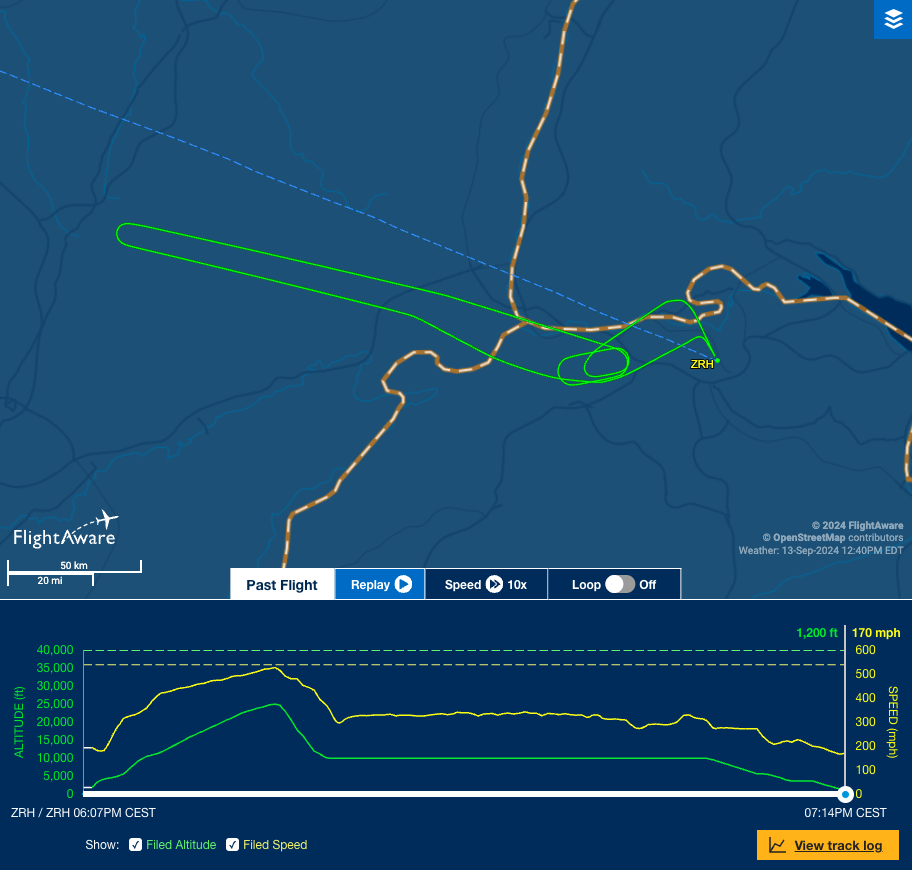On September 13, 2024, Swiss International Airlines flight LX-18, an Airbus A330-300 en route from Zurich to Newark, encountered an in-flight pressurization issue that prompted the pilots to declare an emergency and return to Zurich. The crew’s swift and professional response ensured a safe outcome for all passengers and crew, highlighting the importance of effective procedures and training in aviation safety.
What Happened?
The flight departed Zurich at around 18:00 local time. About 30 minutes after takeoff, the crew detected an issue with the aircraft’s pressurization system and declared an emergency (squawk 7700) to signal the need for priority handling. The aircraft descended to 10,000 feet—a standard response altitude in such situations—and entered a holding pattern near Zurich Airport before safely returning to land.
Understanding Aircraft Pressurization Systems
Aircraft pressurization systems are vital for maintaining a safe and comfortable cabin environment at high altitudes. As an aircraft climbs, the outside air pressure decreases, making it difficult for passengers to breathe without assistance. The pressurization system, which uses compressed air from the engines, maintains a cabin altitude of approximately 6,000 to 8,000 feet, even when the aircraft is cruising at 35,000 feet.
The system consists of several key components, including bleed air valves, air conditioning packs, and outflow valves. A failure in any of these components can result in the cabin not maintaining the required pressure, leading to an emergency situation.
The Seriousness of Pressurization Issues
Pressurization problems can lead to hypoxia, a condition caused by insufficient oxygen reaching the brain, which can result in dizziness, confusion, and loss of consciousness. The higher the altitude, the shorter the “time of useful consciousness” (TUC). At 35,000 feet, the TUC is typically less than 30 seconds without supplemental oxygen.
In such scenarios, oxygen masks deploy automatically. These masks provide 100% oxygen and are essential for keeping passengers and crew conscious until the aircraft can descend to a safer altitude.
The Crew’s Response and Procedures Followed
In the case of flight LX-18, the crew responded quickly and efficiently. Upon identifying the issue, they initiated an emergency descent to 10,000 feet. This altitude allows passengers to breathe comfortably without supplemental oxygen. After stabilizing at this altitude, the aircraft returned to Zurich, where it landed safely without further incident (source: AIRLIVE).

Emergency Descent in High Terrain
If this situation had occurred over high terrain, such as the Himalayas, the crew would have faced additional challenges. In regions where descending to 10,000 feet is not possible due to the terrain’s elevation, the crew must descend to the lowest possible safe altitude and use emergency oxygen systems to sustain life.
Planning routes over such regions involves ensuring adequate oxygen supplies and identifying safe descent paths. This planning is crucial to avoid dangerous outcomes in areas where high terrain limits descent options.
Passenger Experience and Communication
For passengers, the sudden deployment of oxygen masks and emergency descent can be alarming. Clear communication from the crew is essential in such situations to maintain calm and provide necessary instructions. Reports from flight LX-18 indicated that the crew managed the situation with professionalism, keeping passengers informed and calm throughout the incident.
Upon landing, the aircraft was met by emergency services as a precaution. The airline later confirmed that the decision to return to Zurich was made out of an abundance of caution due to a technical issue with the pressurization system.
Lessons Learned
This incident highlights the importance of regular system maintenance and thorough crew training. Quick and effective action by the crew prevented a potentially dangerous situation from escalating. For passengers, it serves as a reminder of the significance of safety briefings and understanding how to use oxygen masks in an emergency.
Conclusion
The LX-18 incident demonstrates the robustness of aviation safety procedures and the effectiveness of well-trained crews in handling unexpected situations. While pressurization issues are rare, they are serious and require immediate attention to ensure passenger and crew safety.
For more information on how aircraft pressurization systems work and why they are crucial for safe flight, check out our comprehensive post on aircraft pressurization. Stay informed and travel safely, knowing that aviation is built on a foundation of rigorous safety standards and procedures.
Leave a Reply